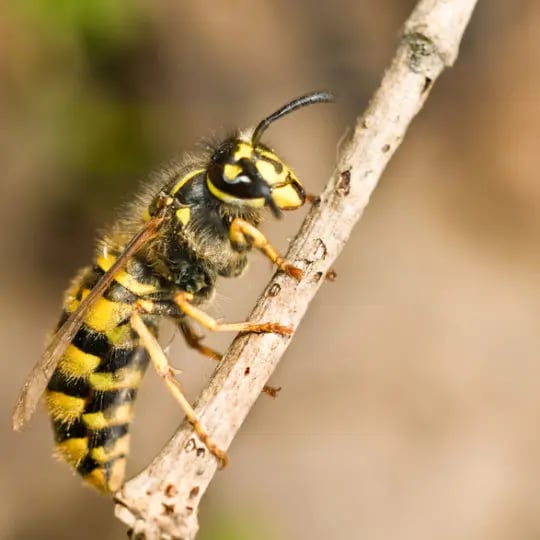
Scientific Name: Polistes humilis
Lifespan: Roughly one year, on average.
Problem: Painful stings. Can sting multiple times.
In an ideal world, humans would be able to leave wasps alone. Wasps are actually beneficial for most homeowners, because they kill off garden pests and are very gentle when away from their hive. Paper wasps (Polistes humilis) feed their young by hunting the garden-killing insects that would otherwise harm your plants and enter your home, and they help pollinate the environment.
But paper wasps are a common pest, primarily because of their defensiveness. Paper wasps prefer not to sting, but they are very territorial and will become aggressive if they think their nest is in danger. They leave painful stings if they or their nests are disturbed or threatened. In creating their nests, they also chew up wooden materials, which can include parts of your house and property.
The Paper Wasp Life Cycle
- Eggs – The eggs of the paper wasp are laid by the queen within the nest. Wasps’ paper grey-brown nests are made from chewed wood pulp. Unlike the nests of yellowjackets or hornets, the hexagonal storage cells the nest is made up of are visible from the outside of the nest.
- Juveniles – Juvenile paper wasps take the form of larvae and pupae, and, like wasp eggs, will remain within the nest until they are fully developed. When larvae cover their cells and become pupae, they are getting close to maturation.
- Mature Bugs – As adults, paper wasps are hard to distinguish from their close cousins, yellowjackets and hornets. They are long-bodied (1.8-2.5 cm long), and clearly segmented, with long, thin, orangeish wings and short orange antennae.
Paper Wasp Habitats and Habits
Paper wasps live on nectar, while their young live on food such as caterpillars. This makes removing their food supply difficult. However, they do tend to build nests where they find a convenient water supply.
Unfortunately for humans, paper wasps will often build their nests in man-made locations, such as the drainpipes and eaves of houses. That’s because homes tend to represent the perfect amount of protection, moisture, and access to materials that paper wasps use for their nests. Once your home has been considered an ideal environment, you’ll often see multiple paper wasp nests pop up around your property, and because these wasps are protective, that means that any time you go towards your home you’re “invading” their property, and you’re at risk for stings.
How to Recognize and Get Rid of Paper Wasp Infestations
If you need wasps removed, it is probably because they have nested somewhere inconvenient such as a porch or basement, or because someone you spend time with is allergic to their stings.
When you are faced with attempting to remove fully active nests, cold temperatures that make wasps sluggish and commercial wasp sprays may also be effective. But keep in mind that taking a paper wasp nest down will rarely prevent another one from putting a nest up, and if your home is really the ideal location, more wasps will come. It’s better to also use preventative pest control to make sure wasps cannot survive near your home.
Need Help with Paper Wasps - Green Pest Solutions?
Call today at and let's talk about how we can help you with Paper Wasps - Green Pest Solutions and other Pest Library.